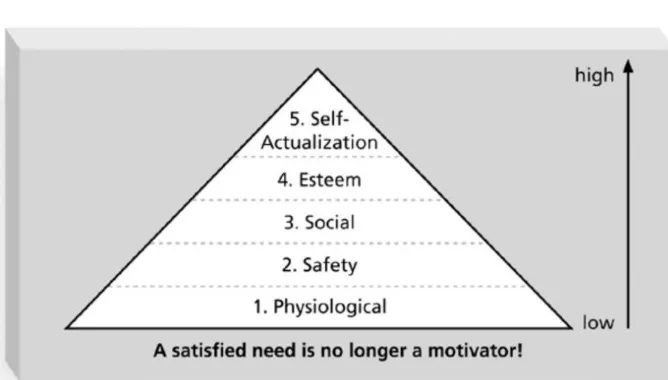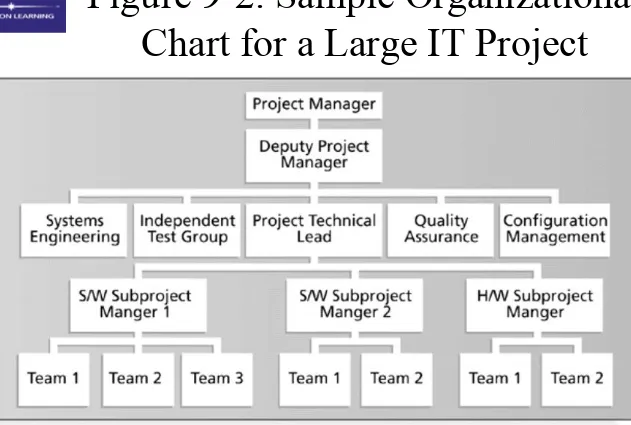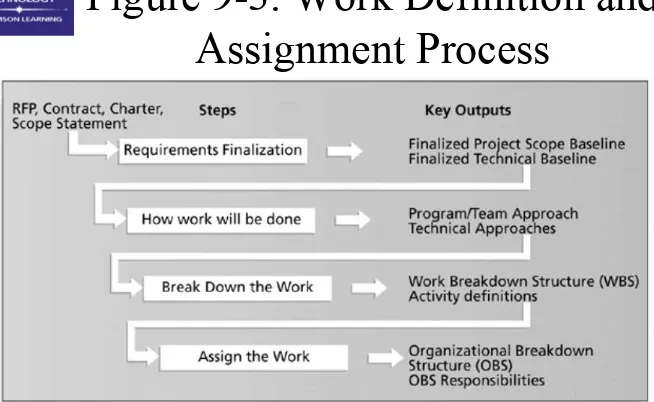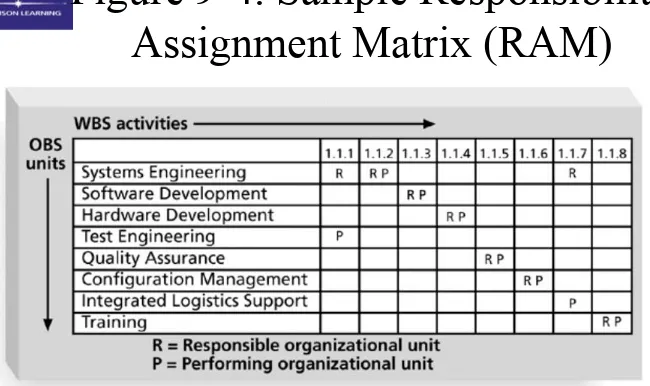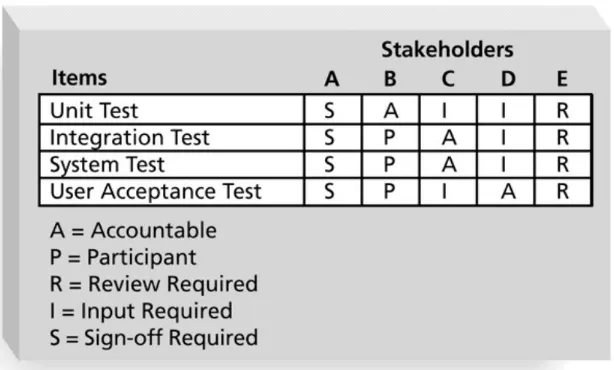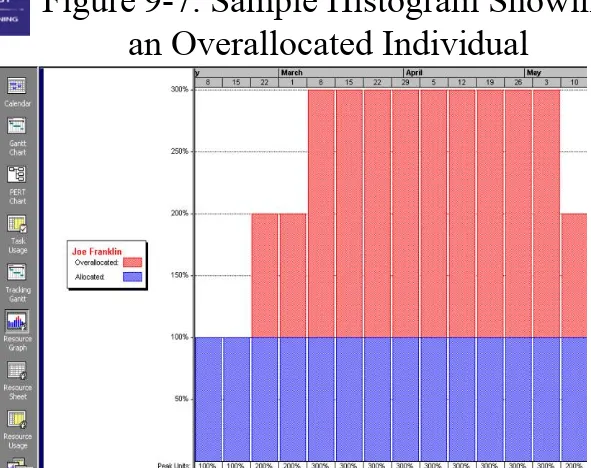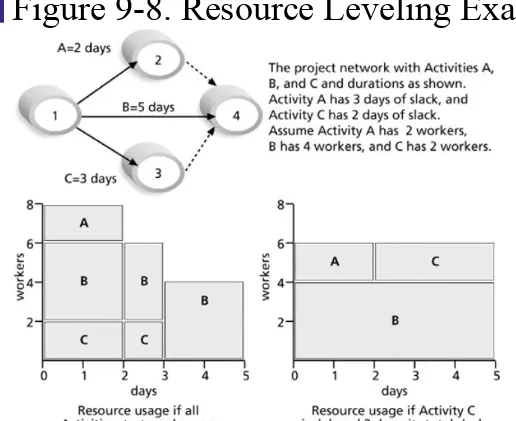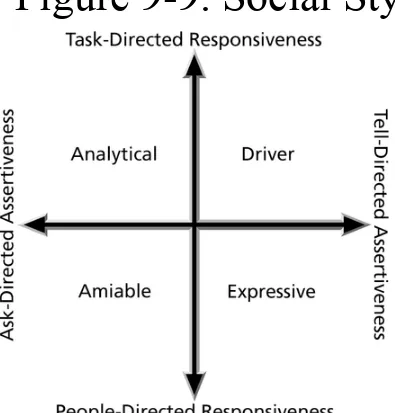Chapter 9:
Learning Objectives
• Explain the importance of good human resource
management on projects, especially on information technology projects
• Define project human resource management and understand its processes
• Summarize key concepts for managing people by understanding the theories of Abraham Maslow, Frederick Herzberg, David McClelland, and
Learning Objectives
• Discuss organizational planning and be able to create a project organizational chart, responsibility
assignment matrix, and resource histogram
• Understand important issues involved in project staff acquisition and explain the concepts of resource
assignments, resource loading, and resource leveling • Assist in team development with training,
team-building activities, and reward systems
The Importance of Human
Resource Management
• People determine the success and failure of organizations and projects
• Recent statistics about IT workforce:
– The total number of U.S. IT workers was more than 10.1 million in December 2002, up from 9.9 million in January 2002
– IT managers predict they will need to hire an
additional 1.2 million workers in the near future – Hiring by non-IT companies outpaces hiring by IT
Digital Planet Reports
• The global high-tech industry generated more than $2.1 trillion in 1999, $2.3 trillion in 2000, and $2.4 trillion in 2001
• The Internet and e-commerce were notable bright spots in the global economy
• Global e-commerce went up 79 percent from 2000 to 2001
Long Hours and Stereotypes of IT
Workers Hurt Recruiting
• Many people are struggling with how to increase and diversify the IT labor pool. Noted problems include:
– The fact that many IT professionals work long hours and must constantly stay abreast of changes in the field
– Undesirable stereotypes that keep certain people away from the career field, like women
– The need to improve benefits, redefine work hours and incentives, and provide better human resource
What is Project Human Resource
Management?
• Project human resource management includes the processes required to make the most
effective use of the people involved with a project. Processes include
– Organizational planning – Staff acquisition
Keys to Managing People
• Psychologists and management theorists have devoted much research and thought to the field of managing people at work
• Important areas related to project management include
– motivation (intrinsic and extrinsic) – influence and power
Motivation
• Abraham Maslow developed a hierarchy of needs to illustrate his theory that people’s behaviors are guided by a sequence of needs • Maslow argued that humans possess unique
qualities that enable them to make independent choices, thus giving them control of their
Herzberg’s Motivational and
Hygiene Factors
• Frederick Herzberg wrote several famous books and articles about worker motivation. He
distinguished between
– motivational factors: achievement, recognition, the work itself, responsibility, advancement, and
growth, which produce job satisfaction
McClelland’s Acquired-Needs Theory
• Specific needs are acquired or learned over time and shaped by life experiences, including:
– Achievement (nAch): Achievers like challenging projects with achievable goals and lots of feedback
– Affiliation (nAff): People with high nAff desire harmonious relationships and need to feel accepted by others, so
managers should try to create a cooperative work environment for them
McGregor’s Theory X and Theory Y
• Douglas McGregor popularized the human relations approach to management in the 1960s
• Theory X: assumes workers dislike and avoid work, so managers must use coercion, threats, and various control schemes to get workers to meet objectives
• Theory Y: assumes individuals consider work as natural as play or rest and enjoy the satisfaction of esteem and self-actualization needs
• Theory Z: introduced in 1981 by William Ouchi and is based on the Japanese approach to motivating workers,
Thamhain and Wilemon’s Ways to Have
Influence on Projects
1. Authority: the legitimate hierarchical right to issue orders
2. Assignment: the project manager's perceived ability to influence a worker's later work assignments
3. Budget: the project manager's perceived ability to authorize others' use of discretionary funds
4. Promotion: the ability to improve a worker's position
5. Money: the ability to increase a worker's pay and benefits 6. Penalty: the project manager's ability to cause punishment
7. Work challenge: the ability to assign work that capitalizes on a worker's enjoyment of doing a particular task
8. Expertise: the project manager's perceived special knowledge that others deem important
Ways to Influence that Help and
Hurt Projects
• Projects are more likely to succeed when project managers influence with
– expertise
– work challenge
• Projects are more likely to fail when project managers rely too heavily on
Power
• Power is the potential ability to influence
behavior to get people to do things they would not otherwise do
• Types of power include
– Coercive – Legitimate – Expert
Improving Effectiveness -
Covey’s 7 Habits
• Project managers can apply Covey’s 7 habits to improve effectiveness on projects
– Be proactive
– Begin with the end in mind – Put first things first
– Think win/win
– Seek first to understand, then to be understood – Synergize
Empathic Listening and Rapport
• Good project managers are empathic listeners; they listen with the intent to understand
• Before you can communicate with others, you have to have rapport
• Mirroring is a technique to help establish rapport • IT professionals often need to develop empathic
Improving Relationships Between
Users and Developers
• Some organizations require business people, not IT people, to take the lead in determining and
justifying investments in new computer systems • CIOs push their staff to recognize that the needs
of the business must drive all technology decisions
Organizational Planning
• Organizational planning involves
identifying, documenting, and assigning
project roles, responsibilities, and
reporting relationships
• Outputs and processes include
– project organizational charts
– work definition and assignment process – responsibility assignment matrixes
Sample RACI Chart
R = responsibility, only one R per task A = accountability
Staff Acquisition
• Staffing plans and good hiring procedures are
important in staff acquisition, as are incentives for recruiting and retention
• Some companies give their employees one dollar for every hour a new person they helped hire works
• Some organizations allow people to work from home as an incentive
• Research shows that people leave their jobs because they don’t make a difference, don’t get proper
Resource Loading and Leveling
• Resource loading refers to the amount of individual resources an existing project
schedule requires during specific time periods • Resource histograms show resource loading
• Overallocation means more resources than are available are assigned to perform work at a
Resource Leveling
• Resource leveling is a technique for resolving resource conflicts by delaying tasks
• The main purpose of resource leveling is to
Team Development
• It takes teamwork to successfully complete most projects
• Training can help people understand
themselves, each other, and how to work better in teams
• Team building activities include
– physical challenges
Meyers-Briggs Type Indicator (MBTI)
• MBTI is a popular tool for determining personality
preferences and helping teammates understand each other • Four dimensions include:
– Extrovert/Introvert (E/I) – Sensation/Intuition (S/N) – Thinking/Feeling (T/F) – Judgment/Perception (J/P)
• NTs or rationals are attracted to technology fields
Social Styles Profile
• People are perceived as behaving primarily in one of four zones, based on their assertiveness and
responsiveness:
– Drivers
– Expressives – Analyticals – Amiables
Reward and Recognition Systems
• Team-based reward and recognition systems can promote teamwork
• Focus on rewarding teams for achieving specific goals
• Allow time for team members to mentor and help each other to meet project goals and
General Advice on Teams
• Focus on meeting project objectives and producing positive results
• Fix the problem instead of blaming people • Establish regular, effective meetings
• Nurture team members and encourage them to help each other
Using Software to Assist in
Human Resource Management
• Software can help in producing RAMs and resource histograms
• Project management software includes several features related to human resource management such as
– viewing resource usage information
Project Resource Management Involves
Much More Than Using Software
• Project managers must
– Treat people with consideration and respect – Understand what motivates them
– Communicate carefully with them
